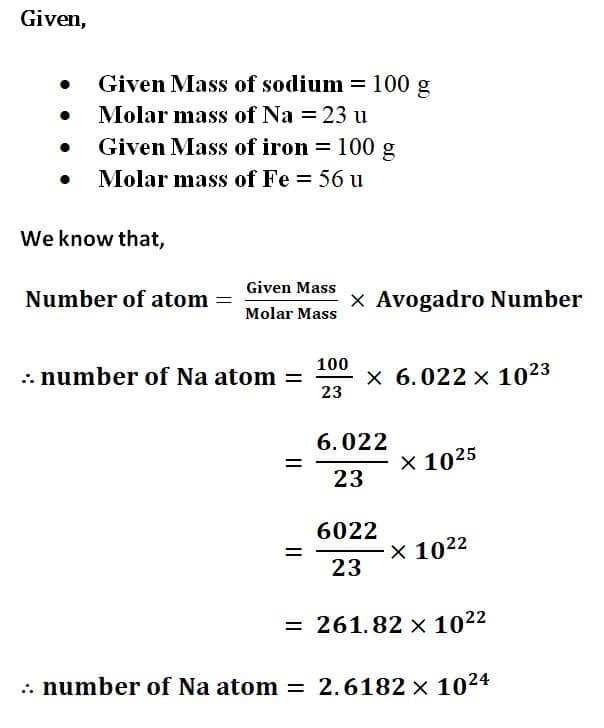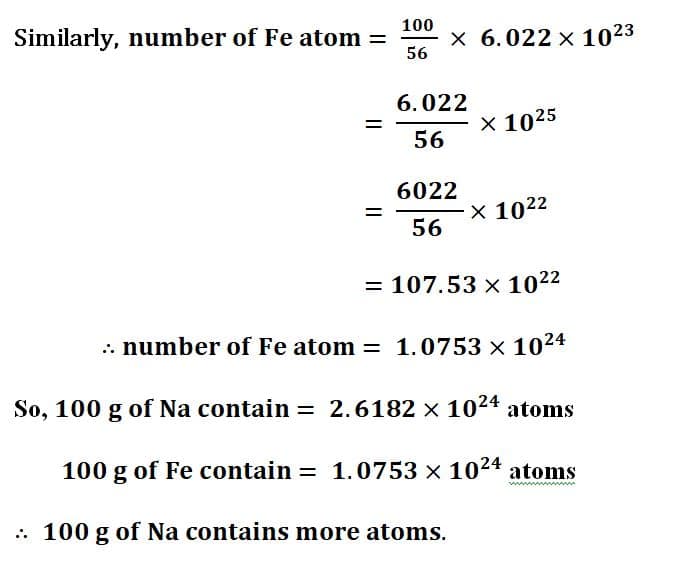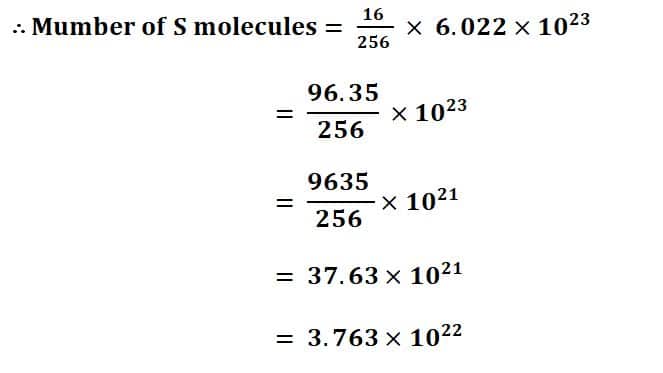NCERT Solutions for Class 9 Science Chapter 3 Atoms and Molecules
Here are the NCERT solutions for Class 9 Science Chapter 3: Atoms and Molecules. This chapter focuses on the basic concepts of atoms and molecules, laws of chemical combination, chemical formulae, molecular mass, and the mole concept. Solutions provided below include both in-text and exercise questions as found in the standard NCERT textbook, along with clear explanations and step-by-step answers.
These solutions are part of NCERT Solutions for Class 9 Science. Here we have given Class 9 NCERT Science Textbook Solutions for Chapter 3: Atoms and Molecules.
Chapter Coverage and Structure
- Laws of Chemical Combination
- What Is an Atom?
- What Is a Molecule?
- Writing Chemical Formulae
- Molecular Mass and Mole Concept
- In-text questions and numerical problems with explanations
NCERT Textbook for Class 9 Science – Page 32
1. In a reaction 5.3 g of sodium carbonate reacted with 6 g of ethanoic acid. The products were 2.2 g of carbon dioxide, 0.9 g water and 8.2 g of sodium ethanoate. Show that these observations are in agreement with the law of conservation of mass carbonate.
Answer.

∴ Total mass of reactants =Total mass of products =11.3 g
Since the mass before reaction equals the mass after reaction, the observations are in agreement with the law of conservation of mass.
2. Hydrogen and oxygen combine in the ratio of 1 : 8 by mass to form water. What mass of oxygen gas would be required to react completely with 3 g of hydrogen gas?
Answer:
Given:
- Ratio of hydrogen : oxygen by mass = 1 : 8
- Mass of hydrogen = 3 g
Therefore, 1 g of hydrogen reacts with 8 g of oxygen
So, 3 g of hydrogen reacts with = 3 g×8 = 24 g
∴ 24 g of oxygen gas would be required to react completely with 3 g of hydrogen gas.
3. Which postulate of Dalton’s atomic theory is the result of the law of conservation of mass?
Answer:
The postulate of Dalton’s atomic theory based on the law of conservation of mass is- ” Atoms are indivisible particles which can neither be created nor destroyed in a chemical reaction“.
4. Which postulate of Dalton’s atomic theory can explain the law of definite proportions?
Answer:
The postulate of Dalton’s Atomic Theory which explains the Law of Definite Proportions is: “The relative number and kinds of atoms are constant in a given compound.”
Class 9 Science NCERT Textbook Page 35
1. Define the atomic mass unit.
Answer:
One atomic mass unit (a.m.u. or u) is defined as exactly one-twelfth (1/12) the mass of a carbon-12 atom. The relative atomic masses of all elements are measured with reference to this standard. It is represented by as ‘a.m.u.’ or ‘u’.
2. Why is it not possible to see an atom with naked eyes?
Answer:
The size of an atom is extremely small, that’s why it is not possible to see it with naked eyes.
NCERT Textbook Questions – Page 39
1. Write down the formulae of
(i) Sodium oxide
(ii) Aluminium chloride
(iii) Sodium sulphide
(iv) Magnesium hydroxide
Answer: The formulae are
(i) Sodium oxide: Na₂O
(ii) Aluminium chloride: AlCl₃
(iii) Sodium sulphide: Na₂S
(iv) Magnesium hydroxide: Mg(OH)₂
2. Write down the names of compounds represented by the following formulae:
Al₂(SO₄)₃
CaCl₂
K₂SO₄
KNO₃
CaCO₃
Answer:-
Al₂(SO₄)₃ : Aluminium sulphate
CaCl₂ : Calcium chloride
K₂SO₄ : Potassium sulphate
KNO₃ : Potassium nitrate
CaCO₃ : Calcium carbonate
3. What is meant by the term chemical formula?
Answer:
The chemical formula of the compound is a symbolic representation of its composition.
For example, the formula CO₂ shows that one atom of carbon joins with two atoms of oxygen to form carbon dioxide.
3. How many atoms are present in a
(i) H2S molecule and
(ii) P043- ion?
Answer:
(i) In one molecule of H₂S, there are 3 atoms — 2 hydrogen atoms and 1 sulfur atom.
(ii) In one PO₄³⁻ ion, there are 5 atoms — 1 phosphorus atom and 4 oxygen atoms.
NCERT Textbook Questions – Page 40
1. Calculate the molecular masses of H2, O2, Cl2, C02, CH4, C2H6 , C2H2,NH3, CH3OH.
Answer: The molecular masses are:
H₂ = 2 × 1 = 2 u
O₂ = 2 × 16 = 32 u
Cl₂ = 2 × 35.5 = 71 u
CO₂ = (1 × 12) + (2 × 16) = 12 + 32 = 44 u
CH₄ = (1 × 12) + (4 × 1) = 12 + 4 = 16 u
C2H6= (2 × 12) + (6 × 1) = 24 + 6 = 30 u
C2H4 = (2 × 12) + (4 × 1) = 24 + 4 = 28 u
NH₃ = (1 × 14) + (3 × 1) = 14 + 3 = 17 u
CH₃OH = (1 × 12) + (4 × 1) + (1 × 16) = 12 + 4 + 16 = 32 u
2. Calculate the formula unit masses of ZnO, Na2O, K2C03, given atomic masses of Zn = 65 u, Na = 23 u, K = 39 u, C = 12 u, and O = 16 u.
Answer: The formula unit mass of
- ZnO = (1 × 65) + (1 × 16)
= 65 + 16
= 81 u - Na₂O = (2 × 23) + (1 × 16)
= 46 + 16
= 62 u - K₂CO₃ = (2 × 39) + (1 × 12) + (3 × 16)
= 78 + 12 + 48
= 138 u
Class 9 Science NCERT Textbook Page 42
1. If one mole of carbon atoms weigh 12 grams, what is the mass (in grams) of 1 atom of carbon?
Answer:
1 mole of carbon = 12 g = 6.022 × 10²³ atoms
∴ Mass of 6.022 × 10²³ atom of carbon = 12 g
⇒ Mass of 1 atom of carbon \( = \frac{12}{6.022 \times 10^{23}} \)
⇒ Mass of 1 atom of carbon = 1.99 × 10⁻²³ g
2. Which has more number of atoms, 100 grams of sodium or 100 grams of iron (given atomic mass of Na = 23 u, Fe = 56 u)?
Answer:


Questions From NCERT Textbook Exercises (page no. 43)
1. A 0.24 g sample of compound of oxygen and boron was found by analysis to contain 0.096 g of boron and 0.144 g of oxygen. Calculate the percentage composition of the compound by weight.
Answer:
Given:
- Mass of compound = 0.24 g
- Mass of boron (B) = 0.096 g
- Mass of oxygen (O) = 0.144 g
We know that,
\( \text{Percentage of an element} = \frac{\text{Mass of element}}{\text{Total mass of compound}} \times 100 \)
For Boron (B): \( \text{Percentage of Boron} = \frac{0.096}{0.24} \times 100 = 40\% \)
For Oxygen (O): \( \text{Percentage of Oxygen} = \frac{0.144}{0.24} \times 100 = 60\% \)
2. When 3.0 g of carbon is burnt in 8.00 g oxygen, 11.00 g of carbon dioxide is produced. What mass of carbon dioxide will be formed when 3.00 g of carbon is burnt in 50.00 g of oxygen? Which law of chemical combination will govern your answer?
Answer: The reaction may be written as:
C + O₂ → CO₂
Where 3 g of carbon reacts with 8 g of oxygen to form 11 g of carbon dioxide. This establishes a fixed mass ratio for the formation of carbon dioxide:
Ratio of C : O₂ = 3 : 8
If 3 g of carbon is burnt in 50 g of oxygen, then 3 g of carbon will react with 8 g of oxygen to form 11 g of carbon dioxide only. The remaining 42 g of oxygen will be left unreacted.
The answer is governed by the law of constant proportions.
3. What are poly atomic ions? Give examples.
Answer:
Polyatomic ions are groups of two or more atoms bonded together that carry an overall positive or negative charge. They behave as a single unit in chemical reactions.
Examples: OH⁻ (hydroxide ion), SO₄²⁻ (sulphate ion), CO₃²⁻ (carbonate ion), NH₄⁺ (ammonium ion).
4. Write the chemical formulae of the following:
(a) Magnesium chloride
(b) Calcium oxide
(c) Copper nitrate
(d) Aluminium chloride
(e) Calcium carbonate.
Answer:
(a) Magnesium chloride: MgCl₂
- Mg (valency 2), Cl (valency 1)
- Formula = MgCl₂
(b) Calcium oxide: CaO
- Ca (valency 2), O (valency 2)
- Ratio simplifies to 1:1
- Formula = CaO
(c) Copper nitrate: Cu(NO₃)₂
- Cu (valency 2), NO₃ (valency 1)
- Formula = Cu(NO₃)₂
(d) Aluminium chloride: AlCl₃
- Al (valency 3), Cl (valency 1)
- Formula = AlCl₃
(e) Calcium carbonate: CaCO₃
- Ca (valency 2), CO₃ (valency 2)
- Ratio simplifies to 1:1
- Formula = CaCO₃
5. Give the names of the elements present in the following compounds:
(a) Quick lime
(b) Hydrogen bromide
(c) Baking powder
(d) Potassium sulphate.
Answer:
| Compound | Chemical Formula & Name | Elements Present |
|---|---|---|
| Quick lime | CaO (Calcium oxide) | Calcium (Ca), Oxygen (O) |
| Hydrogen bromide | HBr (Hydrogen bromide) | Hydrogen (H), Bromine (Br) |
| Baking powder | NaHCO₃ (Sodium hydrogen carbonate) | Sodium (Na), Hydrogen (H), Carbon (C), Oxygen (O) |
| Potassium sulphate | K₂SO₄ (Potassium sulphate) | Potassium (K), Sulphur (S), Oxygen (O) |
6. Calculate the molar mass of the following substances.
(a) Ethyne, C2H2
(b) Sulphur molecule, S8
(c) Phosphorus molecule, P4 (Atomic mass of phosphorus = 31)
(d) Hydrochloric acid, HCl
(e) Nitric acid, HNO3
Answer:
(a) Molar mass of Ethyne, C2H2
\[ \text{C}_{2}\text{H}_{2} = (2 \times 12) + (2 \times 1) = 24 + 2 = 26 \ \text{g/mol} \]
(b) Molar mass of \( S_{8} = (8 \times 32) = 256 \ \text{g/mol} \)
(c) Molar mass of \( P_{4} = (4 \times 31) = 124 \ \text{g/mol} \)
(d) Molar mass of \( HCL = 1 + 35.5 = 36.5\ \text{g/mol} \)
(e) Molar mass of \( \text{HNO}_{3} = (1) + (14) + (3 \times 16) = 1 + 14 + 48 = 63 \ \text{g/mol} \)
7. What is the mass of
(a) 1 mole of nitrogen atoms?
(b) 4 moles of aluminium atoms (Atomic mass of aluminium = 27)?
(c) 10 moles of sodium sulphite (Na2S03)?
Answer:
(a) 1 mole of nitrogen atoms?
Ans:
Atomic mass of N = 14 u
The mass of 1 mole of N- atoms = 14 g
(b) 4 moles of aluminium atoms (Atomic mass of aluminium = 27)?
Ans: Atomic mass of Al = 27 u
\( \text{The mass of 4 moles of Al-atoms} = 4 \times 27 = 108 \ \text{g} \)
(c) 10 moles of sodium sulphite (Na2S03) ?
Ans: Atomic mass of Na = 23 u, Atomic mass of S = 32 u, Atomic mass of O = 16 u
\( \text{Mass of 1 mole of Na}_{2}\text{SO}_{3} \)
\( = (2 \times 23) + (1 \times 32) + (3 \times 16) \)
\( = 46 + 32 + 48 = 126 \ \text{g/mol} \)
\( \text{Mass of 10 moles of Na}_{2}\text{SO}_{3} = 10 \times 126 = 1260 \ \text{g} \)
8. Convert into mole.
(a) 12 g of oxygen gas
(b) 20 g of water
(c) 22 g of Carbon dioxide.
Answer:
(a) 12 g of oxygen gas (O₂)
Given Mass of O₂ = 12g
Molar mass of O₂ = 2×16=32 g
We know that, \( \text{Number of Moles} = \frac{\text{Given Mass}}{\text{Molar Mass}} \)
\( = \frac{12}{32} = 0.375 \ \text{mol} \)
(b) 20 g of water (H₂O)
Given Mass of H₂O = 20g
Molar mass of H2O = (2 x 1) + 16 = 18 g
\( \text{Number of Moles of Water} = \frac{20}{18} \approx 1.11 \ \text{mol} \)
(c) 22 g of carbon dioxide (CO₂)
Given mass of CO₂ = 22 g
Molar mass of CO₂ = (1 x 12) + (2 x 16) = 12 + 32 = 44 g
\( \text{Number of Moles of CO₂} = \frac{22}{44} = 0.5 \ \text{mol} \)
9. What is the mass of:
(a) 0.2 mole of oxygen atoms?
(b) 0.5 mole of water molecules?
Answer:
(a) 0.2 mole of oxygen atoms
Given, Mole of Oxygen atoms = 0.2 mole
Molar mass of 1 O atom = 16 g
We know that, \( \text{Mass} = \text{Moles} \times \text{Molar mass} \)
∴ Mass of oxygen atoms = 16 x 0.2 = 3.2 g
(b) 0.5 mole of water molecules (H₂O)
Given, Mole of water molecule = 0.5 mole
Molar mass of water molecules = 2 x 1 + 16= 18 g
∴ Mass of H2O = 18 x 0.5 = 9 g
10. Calculate the number of molecules of sulphur (S8) present in 16 g of solid sulphur.
Answer:
Given:
- Given mass of sulphur = 16 g
- Molecular formula = S₈
- Atomic mass of S = 32
- Molar mass of S8 sulphur = 8 x 32 = 256 g
We know that,
\( \text{Number of molecules} = \frac{\text{Given Mass}}{\text{Molar Mass}} \times{Avogadro’s number} \)
∴\( \text{Number of molecules} = \frac{16}}{256} \times{6.022\times{10^23}} \)

11. Calculate the number of aluminium ions present in 0.051 g of aluminium oxide. (Hint: The mass of an ion is the same as that of an atom of the same element. Atomic mass of Al = 27 u)
Answer:
Given:
- Given mass of aluminium oxide = 0.051 g
- Formula = Al₂O₃
- Atomic mass of Al = 27 u
- Atomic mass of O = 16 u
∴ Molar mass of aluminium oxide Al203
= (2 x 27) + (3 x 16)
= 54 + 48 = 102 g.
Since, there are two aluminium ions ( Al3+ ) for every one formula unit of Al₂O₃.
∴ Moles of Al3+ = 2 x (Moles of Al₂O₃) = 2 x .0005= .001
Number of Al3+ ions = (Moles of Al3+ ) x ( Avogadro’s Number)
= .001 x 6.022 x 1023 ions
= 6.022 x 1020 ions
NCERT Solutions for Class 9 Science Chapter 1 Matter In Our Surroundings
NCERT Solutions for Class 9 Science Chapter 2 Is Matter Around Us Pure?
NCERT Solutions for Class 9 Science Chapter 3 Atoms And Molecules
NCERT Solutions for Class 9 Science Chapter 4 Structure Of The Atom
NCERT Solutions for Class 9 Science Chapter 5 The Fundamental Unit Of Life
NCERT Solutions for Class 9 Science Chapter 6 Tissues
NCERT Solutions for Class 9 Science Diversity In Living Organism
NCERT Solutions for Class 9 Science Chapter 8 Motion
NCERT Solutions for Class 9 Science Chapter 9 Force And Laws Of Motion
NCERT Solutions for Class 9 Science Chapter 10 Gravitation
NCERT Solutions for Class 9 Science Chapter 11 Work And Energy
NCERT Solutions for Class 9 Science Chapter 12 Sound
NCERT Solutions for Class 9 Science Chapter 13 Why Do We Fall ill
NCERT Solutions for Class 9 Science Chapter 14 Natural Resources
NCERT Solutions for Class 9 Science Chapter 15 Improvement In Food Resources
